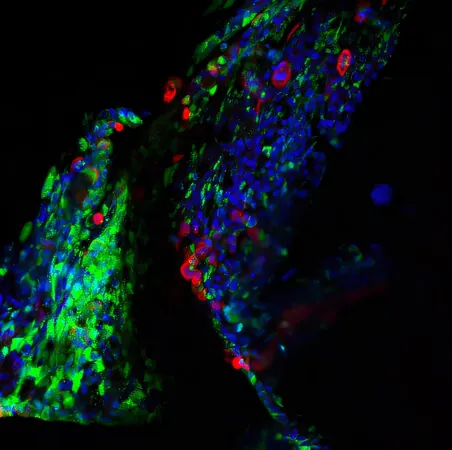
Unlocking the Secrets: How Human Proteins Could Transform Our Fight Against COVID-19
2025-09-05
Author: Siti
Despite significant advancements in vaccines and treatments, SARS-CoV-2, the virus behind COVID-19, remains a formidable global health challenge, fueled by evolving variants and its sinister knack for infiltrating human cells. However, groundbreaking research from Scripps Research has revealed a treasure trove of human proteins that the virus exploits throughout its life cycle—from the moment it invades a cell to the replication and release of new viral particles.
Published in PLOS Biology, these eye-opening findings could pave the way for innovative drug strategies that target our own human proteins instead of the virus itself. This shift could lead to potent new treatments not just for SARS-CoV-2, but for other coronaviruses that may emerge.
Revolutionary Research Methods Expose Viral Vulnerabilities
In a bid to uncover the human proteins that SARS-CoV-2 relies on, researchers utilized a technique called genome-wide small interfering RNA (siRNA) screening. This powerful method allows for the individual inhibition of human genes in cells susceptible to the virus, thus identifying key proteins the virus needs for its replication.
Their research unveiled an impressive 32 proteins crucial during the initial stages of infection and 27 additional proteins that facilitate later viral processes, unveiling a mix of both familiar and novel cellular pathways.
A Game-Changer in Antiviral Strategies
"This research highlights the critical need to understand the virus-host interaction better," stated Sumit Chanda, a professor of immunology and microbiology at Scripps Research and co-senior author of the study. "By pinpointing the human proteins that these viruses rely on, we can establish the groundwork for next-generation pan-coronavirus therapies that could be effective not only against today’s strain but potential future variants like SARS-CoV-3."
Spotlight on Two Promising Drug Targets
Among the diverse proteins identified, two stand out as particularly promising targets for new drugs. The first is perlecan, a sizable protein adorned with sugar chains found in the extracellular matrix—the supportive framework of our cells. The research unveiled that the notorious spike protein of SARS-CoV-2 can latch onto these sugar chains, aiding its entry into human cells. Blocking this interaction could effectively thwart infection.
Laura Martin-Sancho, co-senior author and now an assistant professor of molecular virology at Imperial College London, remarked, "Perlecan appears to act almost like a co-receptor for the virus. Targeting this interaction could stop the infection right at the doorstep."
The second protein, Baculoviral IAP Repeat Containing 2 (BIRC2), plays a role in cellular inflammation pathways. In cultures of human cells and mouse models infected with the virus, drug compounds known as Smac mimetics—designed to activate cell death in cancer therapies—showed a remarkable ability to inhibit BIRC2, significantly reducing viral levels.
A Broader Implication: Targeting the Viral Playbook
Excitingly, the team didn’t stop there. They also tested these human proteins against three other coronaviruses—SARS-CoV-1, MERS-CoV, and a seasonal coronavirus. Out of the 47 proteins examined, 17 were utilized by all three viruses, indicating that blocking these key human proteins may form the foundation for effective drugs addressing current, past, and potentially future coronaviruses.
"If we have such antivirals prepared in advance, we can deploy them swiftly during future outbreaks," Chanda emphasized, noting that this approach offers a formidable barrier against viral resistance while potentially neutralizing multiple viruses with a single treatment.
Next Steps: Expanding the Research Horizon
Looking ahead, the researchers aim to determine whether these crucial host proteins are also utilized by other respiratory pathogens like influenza and RSV. They plan to continue testing the safety and efficacy of these promising compounds in future studies. This innovative approach could redefine our arsenal against not just COVID-19, but a spectrum of viral threats that loom on the horizon.





 Brasil (PT)
Brasil (PT)
 Canada (EN)
Canada (EN)
 Chile (ES)
Chile (ES)
 Česko (CS)
Česko (CS)
 대한민국 (KO)
대한민국 (KO)
 España (ES)
España (ES)
 France (FR)
France (FR)
 Hong Kong (EN)
Hong Kong (EN)
 Italia (IT)
Italia (IT)
 日本 (JA)
日本 (JA)
 Magyarország (HU)
Magyarország (HU)
 Norge (NO)
Norge (NO)
 Polska (PL)
Polska (PL)
 Schweiz (DE)
Schweiz (DE)
 Singapore (EN)
Singapore (EN)
 Sverige (SV)
Sverige (SV)
 Suomi (FI)
Suomi (FI)
 Türkiye (TR)
Türkiye (TR)
 الإمارات العربية المتحدة (AR)
الإمارات العربية المتحدة (AR)